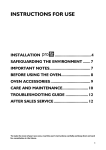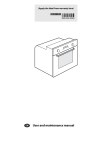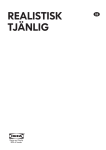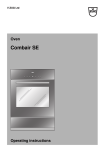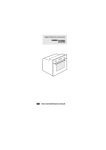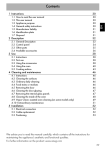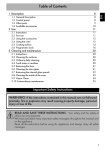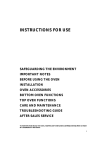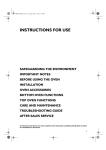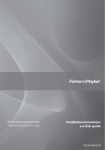Download Whirlpool AKZ 810/IX
Transcript
31056685GB.fm Page 28 Tuesday, March 11, 2008 5:02 PM INSTRUCTIONS FOR USE SAFEGUARDING THE ENVIRONMENT IMPORTANT NOTES BEFORE USING THE OVEN OVEN ACCESSORIES MAINTENANCE AND CLEANING TROUBLESHOOTING GUIDE AFTER-SALES SERVICE To ensure best use of the oven, read all the instructions carefully and keep them for future reference. 28 31056685GB.fm Page 29 Tuesday, March 11, 2008 5:02 PM SAFEGUARDING THE ENVIRONMENT Disposal of packaging materials • The packing material is 100% recyclable and is marked with the recycle symbol . • The various parts of the packing must therefore be disposed of responsibly and in full compliance with local authority regulations governing waste disposal. Disposal of used household appliances • The appliances are built from recyclable materials. When scrapping them, comply with local waste-disposal regulations. Before scrapping, cut off the power cords so that the appliances cannot be connected to the mains. • This appliance is marked in compliance with European Directive 2002/96/EC, Waste Electrical and Electronic Equipment (WEEE). • By ensuring that this appliance is scrapped suitably, you can help prevent potentially damaging consequences for the environment and health. on the appliance or • The symbol accompanying documentation indicates that this product should not be disposed of as unsorted municipal waste. Instead it must be delivered to a suitable collection centre for the recycling of electrical and electronic equipment. Disposal must be carried out in accordance with local environmental regulations for waste disposal. For further information on the treatment, recovery and recycling of this appliance, contact your competent local authority, the collection service for household waste or the shop where you purchased the appliance. Energy saving • Only pre-heat the oven if specified in the cooking table of the Product Description Sheet or in your recipe. • Use dark, black enamelled baking moulds as they absorb heat very well. IMPORTANT NOTES • The appliance is not intended for use by persons (children included) with physical, sensory or mental impairment or without experience and knowledge of the appliance, unless supervised or previously instructed in its use by those responsible for their safety. • The accessible parts of the oven can become very hot during use, therefore keep children away from the appliance. • The appliance becomes very hot during use. Do not touch the heating elements inside the oven. • This oven is designed solely for use as a home appliance for cooking food. No other type of use is permitted. The Manufacturer declines all responsibility for inappropriate use or incorrect setting of the controls. • Any repairs or adjustments must be carried out exclusively by a qualified technician. • Do not expose the oven to atmospheric agents. • Do not place heavy objects on the door as they could damage the oven cavity and hinges. • Do not cling to the door. • Never hang anything heavy on the oven door handle. • Do not cover the bottom of the oven with aluminium foil or other objects. • The oven door must close properly. The door seals must be kept clean. • Do not pour water directly into the inside of a hot oven. The enamel coating could be damaged. • Fruit juice dripping from the baking tray may leave permanent stains. We recommend the oven be cleaned before reusing it. • Never drag pots and pans across the bottom of the oven to prevent the coating from being scratched. • During steam cooking, any condensation on the door glass is only due to the presence of steam in the oven compartment. • The steam injection pipe outlet nozzle must never be obstructed by containers or pans. • Periodically clean the steam nozzle to prevent it from becoming clogged with food residue or grime which could comprise proper use. 29 31056685GB.fm Page 30 Tuesday, March 11, 2008 5:02 PM • Over time, residual condensation from cooking could damage the oven and surrounding kitchen units. It is advisable to: - set the lowest temperature; - cover food; - remove food from the oven; - dry wet parts once the oven is cool. • The oven generates steam, therefore take care when opening the door. • Do not pour water in the filling drawer during the cleaning cycle. • Do not pour flammable liquids or spirits (grappa, whisky, brandy, etc.) in the filling box. • Do not pour too much water in the drawer; always observe the amounts recommended in the recipes or cooking tables. In the event of overfilling, the water will overflow inside the oven; dry the excess water with a sponge or cloth. • Unless otherwise specified, the oven door must be closed for cooking. • Overheated oils and fats catch fire easily. It is dangerous to heat oils and fats in the oven. • Never leave the appliance unattended during food drying. • Do not cover pots with lids during steam operation. • The water filling drawer must be closed during cooking and the pyrolytic cycle. • It is advisable to fill the drawer with drinking water or low mineral content water. Do not use distilled water or any other liquid. • Never touch the oven with any wet part of the body and do not operate it with bare feet. • Do not pull the appliance or the power cable to unplug it. • Do not allow children to touch: - the oven or its controls, especially when in operation and immediately afterwards to avoid injury; - packaging materials (bags, polystyrene, metal parts, etc.); - an oven to be scrapped. • Make sure that the electrical cables of other appliances used near the oven do not touch hot parts and are not trapped in the oven door. • Some oven models are equipped with an air cooling system to prevent the front of the oven and cabinet cavity from reaching excessively high temperatures. Important: Hot air is vented through an opening located between the control panel and the oven door. Do not obstruct the vent opening. • Do not place inflammable material in the oven or nearby: it could catch fire if the oven is inadvertently switched on. • Use oven gloves to remove pans and accessories, when the oven is hot. • If alcoholic beverages are added when roasting or cooking cakes and sweets (for example. rum, cognac, wine, etc.) remember that alcohol evaporates at high temperatures. The alcohol vapours could catch fire when coming into contact with the electrical heating element. • Do not heat or cook sealed jars or containers in the oven. The pressure that develops inside the packaging might cause it to explode, damaging the oven. • Do not use containers made of synthetic material for cooking (except for packages specifically designed for this purpose; see the manufacturer's instructions). They could melt at high temperatures. • Never pull out fully loaded shelves. Exercise extreme caution. BEFORE USING THE OVEN • Before using the appliance, remove: - stickers on the front and oven door, except for the rating plate; - cardboard protection and protective plastic film from the front panel controls and other parts of the oven; 30 - any sticky labels from the accessories (for example, under the drip tray). • Remove the accessories from the oven and heat it at 200°C for about an hour to eliminate the smell and fumes of the protective grease and insulating materials. The window should be kept open during this operation. 31056685GB.fm Page 31 Tuesday, March 11, 2008 5:02 PM OVEN ACCESSORIES Accessories supplied depend on the model. The accessories provided with the oven are listed in the Product Description Sheet provided separately (under Accessories). Drip tray (1) The drip tray is designed to collect fat and food particles when it is positioned under the grid or as a plate, such as when cooking meat, chicken and fish with or without vegetables. Pour a little water in the drip-tray to prevent spatters of fat and smoke. 1 Baking tray (2) For cooking biscuits, cakes and pizzas. 2 Grille shelf (3) The grille shelf can be used to grill food or as a support for baking trays, cake tins and other cooking receptacles. It can be placed on any level available. The grille must be inserted with the curvature facing upwards. 3 Grill Pan Set (4) (optional) The set comprises a grille (4a), an enamelled recipient (4b) and one or two handles (4c). This set must be placed on the grille (3) and used with the “Grill” function. 4a 4c 4b 4 Grease filter (5) (optional) Use only for particularly greasy cooking. Hook it on the rear wall of the compartment, opposite the fan. It can be cleaned in a dishwasher; do not use it with the “Hot air” function or “steam” function, so as not to alter the cooking results. 5 31 31056685GB.fm Page 32 Tuesday, March 11, 2008 5:02 PM MAINTENANCE AND CLEANING Important: Never use steam jet cleaners. Accessories Oven exterior and inner trim in steel • Soak the accessories in water with dish washing detergent immediately after use. Food residues can be easily removed using a sponge. • To avoid scratching or breaking the door glass, do not use coarse abrasive materials or sharp metal scrapers for cleaning. • Clean with a damp cloth. If it is very dirty, add a few drops of dish washing detergent to the water. Dry with a soft cloth. • Do not use corrosive or abrasive detergents, which can dull the surface. In the event that one of these products comes into contact with the oven, immediately clean it using a damp cloth. • Slight colour differences on the front of the appliance are due to the use of different materials, such as glass, plastic and metal. • Use and soft dry cloth to clean the water filling drawer. Oven compartment • Do not use abrasive sponges or metal scouring pads. Use proprietary oven detergents, following the manufacturer's instructions. • After every use, allow the oven to cool then clean it to prevent the build-up of baked-on food residues. • During prolonged cooking or simultaneous cooking on several levels, especially in the case of food containing lots of water (pizza, stuffed vegetables, etc.), condensation may form on the inside of the door and around the seal. When the oven is cold, dry the inside of the door with a cloth or sponge. • Clean the door glass with a suitable liquid detergent. • The oven door can be removed to facilitate cleaning. Removing the door Important: Wear protective gloves when carrying out the following operations. Follow these instructions carefully in order prevent injury and to avoid damaging the oven or its hinges. How to remove the oven door: • Wear protective gloves; • Open the oven door fully (see fig. 1); • Lift the two hinge catches and push them forwards to the stop (see fig. 2). • Close the door enough to remove it, pulling upwards (see fig. 3). To remount the door: • Insert the hinges in their grooves and lower the door completely (fig.3); • Lower the two catches (fig.2); • Close the oven door fully. Changing the rear oven lamp bulb: • Disconnect the oven from the electrical supply. • Allow the oven to cool before turning the lamp cover anticlockwise to unscrew it (see fig. 4). • Replace the lamp (see Note). • Screw the lamp cover back on. • Reconnect the oven to the electrical supply. N.B: Only use 25W - 230 V, E-14 type, T 300°C lamps, available from our After-Sales Service Centre. Important: Do not use the oven until the lamp cover has been repositioned. 1 2 3 4 32 31056685GB.fm Page 33 Tuesday, March 11, 2008 5:02 PM TROUBLESHOOTING GUIDE The oven does not work: • Check for the presence of mains electrical power and if the oven is connected to the electrical supply. • Switch the oven off and then on again to see if the fault has been eliminated. If the door will not open: • Switch the oven off and then on again to see if the fault has been eliminated. Important: • Make sure the oven control knob is not turned to “0”. ”, • If the electronic programmer indicates “ consult the separate Product Sheet and/or the electronic programmer description. • If the electronic programmer indicates “F HH”, contact the nearest After-sales Service. Specify in this case the number that follows the letter “F”. AFTER-SALES SERVICE Before calling the After-sales Service: 1. Try to solve the problem yourself, following the points described in “Troubleshooting Guide”. 2. Switch the appliance off and then on again it to see if the problem has been eliminated. If the fault persists after the above checks, contact the nearest After-sales Service. Always specify: • a brief description of the fault; • the type and exact model of the oven; • the service number (number after the word Service on the rating plate), located on the right hand edge of the oven cavity (visible when the oven door is open). the After-Sales Service number is also given in the warranty booklet; • your full address; • your telephone number. If any repairs are required, contact an authorised After-sales Technical Service (to guarantee the use of original spare parts and correct repair). Failure to comply with these instructions may compromise the safety and quality of the product. DECLARATION OF CONFORMITY’ • This oven is intended to come into contact with food products and complies with regulation (EC) no. 1935/2004. • It is designed only for use as a cooking appliance. Any other use (e.g. for room heating) is considered improper and therefore potentially dangerous. • This appliance has been designed, constructed and sold in compliance with: - the safety requirements of “Low Voltage” Directive 2006/95/EC (replacing 73/23 EEC as amended). - The protection requirements of EMC Directive 89/336/EEC. - The requirements of Directive 93/68/EEC. 33






